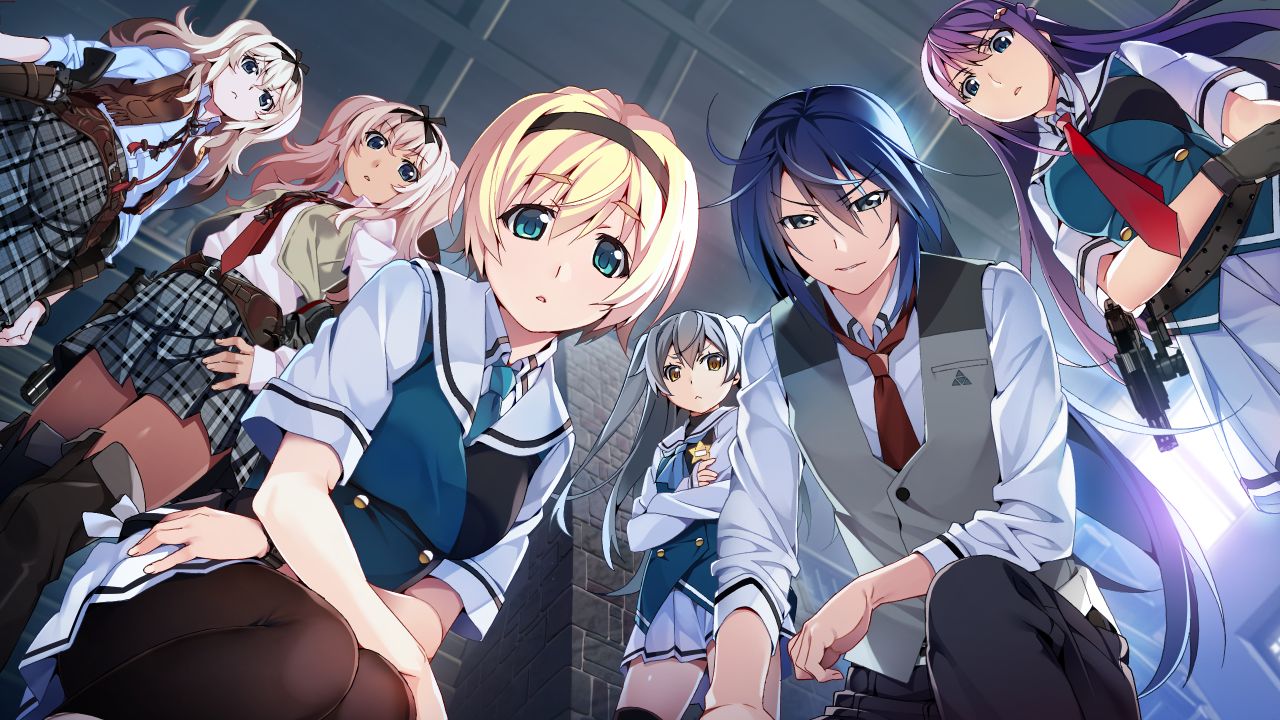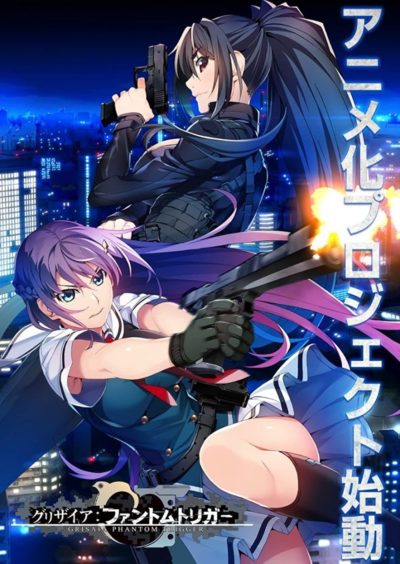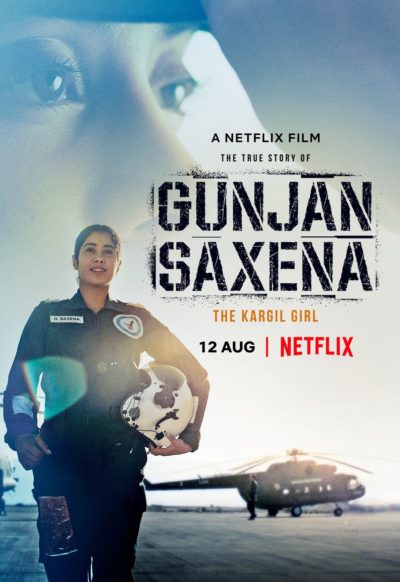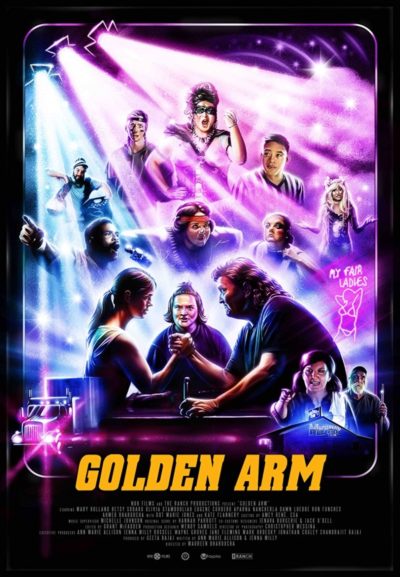 ★★★
★★★
“Time changes everything… or does it?”
DISCLAIMER: I have no knowledge on the backstory of this series. Grisaia Phantom Trigger – The Animation is the latest story in the Grisaia universe, that originally began as a series of “visual novels” (which as I understand, have more in common with a computer game), was then turned into a manga and the 13-episode anime series The Fruits of Grisaia which got two sequels, The Labyrinth of Grisaia (a TV movie) and The Eden of Grisaia (10 episodes), before we reached where we are here. GPT-TA is the new stand-alone film of that series, which came out last year and was also shown in cinemas. As none of the above mentioned series or films have been dubbed and released in Germany, my home country, I never saw anything before this movie. I belong to those anime fans who prefer to see their stuff in a language they can understand.
But that actually doesn’t matter at all, for this film serves as a very good introduction to the uninformed like myself. It therefore can be watched by those who have never seen an episode of this series before. As a matter of fact, the film consists of two longer episodes, combined into a movie, that thus tells us two separate stories. The first part serves as an introduction, which I felt was a bit dialogue-heavy. The second half was around 15 minutes longer than the first and provided more of the action stuff that fans love. But the way it was done was very nice.
 So, what’s it all about? There was a US-Japanese anti-terrorism organisation called CIRS: after having become public knowledge, a new agency for covert operations was created, called SORD (Social Ops, Research and Development). This organisation has established many schools within the country, where homeless poor orphans from unfortunate backgrounds are being trained and schooled to protect the country (meaning: to kill people).
So, what’s it all about? There was a US-Japanese anti-terrorism organisation called CIRS: after having become public knowledge, a new agency for covert operations was created, called SORD (Social Ops, Research and Development). This organisation has established many schools within the country, where homeless poor orphans from unfortunate backgrounds are being trained and schooled to protect the country (meaning: to kill people).
In this particular school, where the orphans consist solely of young girls, the teenagers are taken care of by a young man Haruto, who with his long hair almost looks like a woman himself. He could have his own interesting backstory – he doesn’t shoot, but has others do it for him – something I suspect happened in one of the prequel shows. Than there’s sharp-shooter Touka; the Russian Ninja Murasaki; hot-shot action-girl Rena, who’s totally devoted to her ‘Master’ Haruto; Chris, the “mother” of the team, a handsome woman; and the female (and underdressed!) director. There are a couple more characters, but they hardly have much more than a cameo.
The teen girls are nice, and love to banter and bicker with each other in the way normal pupils would in school. But when they are on a mission they make, as we say in Germany, “nails with heads” – meaning they definitely don’t take prisoners. Seeing these otherwise lovely girls, delivering head-shots here and there quite bewildering to me, It was also a bit much for the new teacher, Miss Arisaka, who is kidnapped in the first episode, though still decided she would continue her new job at this unusual school.
The second part then gets into the real action. It’s a more complex story about a comatose former agent who gets kidnapped from a ship. When the girls find him, he’s dead, his heart having been ripped out. The team finds out that the heart, that was originally supposed to go to a leader of the secret service, has been stolen by Russians who have been duped by the seller, who sold the same heart twice. After they recover the heart, they get tricked immediately again by a false courier. As young hot-shot Rena pursues the courier, and then the woman the heart has been given to, she finds out much to her surprise that the woman is her childhood friend Maki, with whom she spent time on the streets, trying to survive.
It’s that second act that makes me like this movie especially. Sure, the idea of hero and villain having a history together, is nowadays an old, almost beaten-to-death cliche. But unlike a recent Bond movie, where the connection is only unimaginatively drawn, and never given any emotional meaning, this small anime film does so much more (and better) with the idea. In that childhood, they called themselves “Sics” and “Bucks” – Rena found Maki behind a coffee shop – and lived on the streets, fighting for food, which they shared. A gangster decided that Rena should become a killer and Maki a prostitute, but as things went on also Maki became a killer, the right-hand woman for heartsick Russian mob boss, Alexej Nicolaijewich. She is as devoted to her master as Rena is to hers, leading to a very intense fight, first with guns then with bare hands.
 Though just 88 minutes long, this is very well done. The few short scenes of the childrens’ childhood give their fight more meaning then the talked about (but never really felt) conflict between for example 007 and 006 in GoldenEye. The fight itself is well-choreographed, looks believable (I’m very well aware I’m talking about an anime!), has exactly the right length and comes across as deliciously hard. And while the whole story about the stolen heart is solved in the end, I liked that this movie doesn’t end the way one would expect. The otherwise trigger-happy Rena doesn’t kill Maki, and also learns about her responsibility to follow orders from Haruto. So there’s a learning curve here.
Though just 88 minutes long, this is very well done. The few short scenes of the childrens’ childhood give their fight more meaning then the talked about (but never really felt) conflict between for example 007 and 006 in GoldenEye. The fight itself is well-choreographed, looks believable (I’m very well aware I’m talking about an anime!), has exactly the right length and comes across as deliciously hard. And while the whole story about the stolen heart is solved in the end, I liked that this movie doesn’t end the way one would expect. The otherwise trigger-happy Rena doesn’t kill Maki, and also learns about her responsibility to follow orders from Haruto. So there’s a learning curve here.
As Nicolaiewich has died peacefully, Maki has no interest in following the Russian gangsters: her obligation was to Nicolaiewich not the organisation. Following Rena’s request, Haruto is taking her under his wing to become a new member of the team. I liked this ending as something different to what a Hollywood actioner would typically serve us. Also, twisting cliches is something I find very rewarding storywise. It’s quite astonishing that big blockbusters in Hollywood can’t be written and directed with the same care as much smaller budgeted Japanese anime. The storytelling in Hollywood’s entertainment industry has really declined sharply, in my opinion. This movie shows you don’t need a big budget to add some more personal touches to your main characters.
The animation itself is well done – good but probably not great, as there are a couple of static images, probably to save money. Also remarkable: this anime was able to tell its story without the typical ecchi or anime humour, so no panty- or booby-shots. The main focus is on the drama and interaction of the different characters, though I couldn’t complain about the action. It was a good mix of both elements. Also, I can say the German dubbing was very well-done. The German voice actresses sound much more grown-up than those in the Japanese dub (I listened for a minute into it) where the girls sounded all very kawai, very cute… The dialogue itself sounded very believable in the German version, especially the bantering and the saucy/funny comments of the girls.
The only minor complaint in my book is that I felt this is a great beginning for a series I would like to continue. Unfortunately, it is (at least for the time being) the end point of the story as far as any German releases are concerned. Well, who knows… maybe the DVD label will now also release the sequel Grisaia Phantom Trigger – The Animation: Stargazer and the sequel series Grisaia: Phantom Trigger that was announced recently?
Dir: Motoki Tanaka
 Nineteen years after the original, four-time Oscar nominated director Lumet opted to remake Cassavetes’s movie. Though by some accounts, it was more a case of him wanting to work, rather than being particularly attracted to the project. If the results are anything to go by, he should have stayed at home. For the film was a bomb, and leading lady Stone received a Razzie nomination for her efforts. I wouldn’t have said she was that bad, though she’s clearly not at the same level as Gina Rowlands in the original. It does also address some of what I felt were its’ predecessor’s weaknesses. However, it tones down the central character, and this helps lead to what you’d be hard-pressed to argue is other than an inferior product overall.
Nineteen years after the original, four-time Oscar nominated director Lumet opted to remake Cassavetes’s movie. Though by some accounts, it was more a case of him wanting to work, rather than being particularly attracted to the project. If the results are anything to go by, he should have stayed at home. For the film was a bomb, and leading lady Stone received a Razzie nomination for her efforts. I wouldn’t have said she was that bad, though she’s clearly not at the same level as Gina Rowlands in the original. It does also address some of what I felt were its’ predecessor’s weaknesses. However, it tones down the central character, and this helps lead to what you’d be hard-pressed to argue is other than an inferior product overall.




 This one was probably teetering on the edge of a seal of approval, except one aspect. For what’s supposed to be book one in a series, the author spends a lot of time discussing events prior to the book getting under way, such as the tragic loss of the heroine’s true love. However, subsequent research revealed that this is not the start of Caina Amalas’s history. The Ghost Exile series is actually a sub-set of her saga, which appears to consist of no less than 26 primary works. According to
This one was probably teetering on the edge of a seal of approval, except one aspect. For what’s supposed to be book one in a series, the author spends a lot of time discussing events prior to the book getting under way, such as the tragic loss of the heroine’s true love. However, subsequent research revealed that this is not the start of Caina Amalas’s history. The Ghost Exile series is actually a sub-set of her saga, which appears to consist of no less than 26 primary works. According to  ★★★
★★★ So, what’s it all about? There was a US-Japanese anti-terrorism organisation called CIRS: after having become public knowledge, a new agency for covert operations was created, called SORD (Social Ops, Research and Development). This organisation has established many schools within the country, where homeless poor orphans from unfortunate backgrounds are being trained and schooled to protect the country (meaning: to kill people).
So, what’s it all about? There was a US-Japanese anti-terrorism organisation called CIRS: after having become public knowledge, a new agency for covert operations was created, called SORD (Social Ops, Research and Development). This organisation has established many schools within the country, where homeless poor orphans from unfortunate backgrounds are being trained and schooled to protect the country (meaning: to kill people). Though just 88 minutes long, this is very well done. The few short scenes of the childrens’ childhood give their fight more meaning then the talked about (but never really felt) conflict between for example 007 and 006 in GoldenEye. The fight itself is well-choreographed, looks believable (I’m very well aware I’m talking about an anime!), has exactly the right length and comes across as deliciously hard. And while the whole story about the stolen heart is solved in the end, I liked that this movie doesn’t end the way one would expect. The otherwise trigger-happy Rena
Though just 88 minutes long, this is very well done. The few short scenes of the childrens’ childhood give their fight more meaning then the talked about (but never really felt) conflict between for example 007 and 006 in GoldenEye. The fight itself is well-choreographed, looks believable (I’m very well aware I’m talking about an anime!), has exactly the right length and comes across as deliciously hard. And while the whole story about the stolen heart is solved in the end, I liked that this movie doesn’t end the way one would expect. The otherwise trigger-happy Rena  While a quick read, at 205 pages, after slogging through a couple of what can only be described as “chonkers”, I really didn’t mind. It’s briskly-paced, hits the ground running and largely doesn’t stop thereafter. I have some concerns about where things might go in subsequent volumes, so will probably stop here, just to be safe. However, I enjoyed what I read well enough.
While a quick read, at 205 pages, after slogging through a couple of what can only be described as “chonkers”, I really didn’t mind. It’s briskly-paced, hits the ground running and largely doesn’t stop thereafter. I have some concerns about where things might go in subsequent volumes, so will probably stop here, just to be safe. However, I enjoyed what I read well enough.
 There is a good concept here. Unfortunately, rarely have I seen an idea so conspicuously derailed by dreadful execution. Let’s not get ahead of ourselves though, and begin by focusing on the positives here. Dawn (Morgan) is a truck driver who is on a cross-country route, and pulls off the road into a remote, wooded location for an obligatory rest stop. Barely has she come to a halt, when a terrified young woman, Phoebe (Gobin), shows up outside her cab, demanding help. She claims to have been abducted, and been held nearby. But she managed to escape from her kidnapper, who is now hot on her heels, with evil intentions. However, is the new arrival speaking the truth or is she dangerously deranged?
There is a good concept here. Unfortunately, rarely have I seen an idea so conspicuously derailed by dreadful execution. Let’s not get ahead of ourselves though, and begin by focusing on the positives here. Dawn (Morgan) is a truck driver who is on a cross-country route, and pulls off the road into a remote, wooded location for an obligatory rest stop. Barely has she come to a halt, when a terrified young woman, Phoebe (Gobin), shows up outside her cab, demanding help. She claims to have been abducted, and been held nearby. But she managed to escape from her kidnapper, who is now hot on her heels, with evil intentions. However, is the new arrival speaking the truth or is she dangerously deranged? And, yet… Not only did I finish this, I genuinely enjoyed the whole, lunatic experience. I don’t know if the editing got slightly better as the book went on. Maybe I just became used to the style, which flies defiantly in the face of, not just all literary convention, but the basic rules of English. Bizarrely, by the end, I found myself almost appreciative of the stream of consciousness, neo-Joycean approach. It’s better demonstrated by example, than description, so here’s a sample paragraph – neither particularly good nor bad by the book’s standards:
And, yet… Not only did I finish this, I genuinely enjoyed the whole, lunatic experience. I don’t know if the editing got slightly better as the book went on. Maybe I just became used to the style, which flies defiantly in the face of, not just all literary convention, but the basic rules of English. Bizarrely, by the end, I found myself almost appreciative of the stream of consciousness, neo-Joycean approach. It’s better demonstrated by example, than description, so here’s a sample paragraph – neither particularly good nor bad by the book’s standards: Warning: while this review contains no spoilers for the book I’m reviewing, it inevitably involves some spoilers for the book to which it’s a sequel, Anna Dressed in Blood. (I didn’t review that one here; see below). The situation in this book directly grows out of the events of the first one; and though the author provides some brief references to those in the opening chapters here, if you have not read the series opener, you would get only the very bare basics of what happened there. IMO, she expected that her readers will read the books in order, and I would strongly recommend doing so. Your whole understanding of the premise here, your engagement with the story, and your understanding of who most of the major characters are as people and your emotional connection to them will be seriously impaired if you don’t!
Warning: while this review contains no spoilers for the book I’m reviewing, it inevitably involves some spoilers for the book to which it’s a sequel, Anna Dressed in Blood. (I didn’t review that one here; see below). The situation in this book directly grows out of the events of the first one; and though the author provides some brief references to those in the opening chapters here, if you have not read the series opener, you would get only the very bare basics of what happened there. IMO, she expected that her readers will read the books in order, and I would strongly recommend doing so. Your whole understanding of the premise here, your engagement with the story, and your understanding of who most of the major characters are as people and your emotional connection to them will be seriously impaired if you don’t!
 The sport of arm-wrestling has been featured in the movies before, most notably the Sylvester Stallone vehicle, Over the Top. But that wasn’t a comedy – at least, not intentionally. This entry, as well as switching to the distaff side, also has its tongue in cheek, while still sporting a strong message about female empowerment, that never becomes a lecture. If you’re looking for an inspiration I’d saw the
The sport of arm-wrestling has been featured in the movies before, most notably the Sylvester Stallone vehicle, Over the Top. But that wasn’t a comedy – at least, not intentionally. This entry, as well as switching to the distaff side, also has its tongue in cheek, while still sporting a strong message about female empowerment, that never becomes a lecture. If you’re looking for an inspiration I’d saw the